
If you have a young child, you know that they have more fun when they are naked. Come to think of it, doesn't everybody have more fun when they're naked? Motorcycling is actually an exception; the rider gets either very cold or very sunburned, plus nude riding is illegal in most parts of the world.
However, that doesn't mean your bike can't be naked. There is something very appealing about the elemental, basic look of a motorcycle that is free of windshield and bodywork. With nothing covering the mechanical elements, the observer sees the basic nature of what makes motorcycling wonderful; a big engine and a pair of wheels. It's saying to the world: this is all we need to move around and have a good time.
Every manufacturer offers such a machine, and here at MO we have a fondness for the biggest, fastest and best-handling around. In August we tested the offerings of the Japanese factories, picking Yamaha's FZ-1 as the victor. But a hue and cry rose from our discussion boards; where are the European bikes in this test?
Luckily, Aprilia's people called us up and asked if we wanted to ride around on a new Tuono 1000R for a few weeks. We had barely hung up the phone when we got a call from BMW's Ministry of Corporate Communications inviting us to the launch of their R1200R naked twin. And the nice people at Cagiva offered us the use of the fearsome and beautiful MV Agusta Brutale 910S. Sometimes we have to do a lot of organizing for comparison tests to happen, and sometimes they kind of fall into our laps.
With three bikes in place, we needed an expert in both being nude and owning exotic bikes. Perhaps you remember MOron Buzglyd? Arthur "Buzz" Waloch has been a friend-of-MO for years, assisting us with our first Euro-streetfighters story in 2004. He also owned a Brutale 750, so who better to come along, give us some riding impressions and help do his part to correct Southern California's massive fried-food trade imbalance?
So how did they stack up? Let's find out.
The Contenders
2007 BMW R1200R$13,025 ($14,990 as tested) 102.08hp 79.12 ft-lbs 437 pounds (claimed dry weight)
Lately, BMW has been getting closer to hitting the nail on the oil-cooled head. The spinning-propellerites have in the last few years have offered both a 150hp superbike and a 100-plus horsepower version of their oil-cooled boxer twin. They've even started using frames. Last year they introduced the beautiful and sporty high-performance R1200S, and for 2007 they present the naked roadster version of that bike, the R1200R.
We sent Pete to the R1200R intro in Dana Point, CA, where he learned some more about what makes the R1200R an important new model for BMW. Although BMW's PR people and engineers greatly stressed the electronic innovations like the partial-integral ABS and the quasi-traction control ASC system, there are plenty of changes in the chassis, suspension and motor.
Get Up to Date With BMW's Acronym Frenzy
Partial-Integral ABS ($1040)
Out with those noisy, power-assisted integrated ABS brakes and in with the latest-generation, partial-integral-valve system ABS.
It seems BMW heard the cries of the media -- and more importantly the buying public -- and opted to update and simplify their ABS. This current generation -- number four, if you want to be technical -- of BMW ABS is actually an enhanced version of the BOSCH system introduced on the F650GS in 2000. Front braking is effected in the traditional sense in that a simple hydraulic circuit applies pressure on the rotors when you apply pressure at the brake lever. The "partial" part comes into play when an electronically controlled hydraulic pump gradually builds and applies pressure to the rear when the rider squeezes the front lever. But try to get the front brakes to work by simply pushing on the rear brake pedal and you'll be disappointed -- or very happy. Two completely separate circuits are in operation. The cynics among you will be happy to hear that the front brakes will have the familiar feel of any other bike out there. One advantage is that you won't have to make a mental note after transitioning from a bike with this new ABS system to a non-ABS equipped. Many of you probably learned this the hard way on previous Beemer systems.
Oh yeah, one more thing. Unlike the power-assisted days of yore -- when the bike's ignition switch had to be on to activate full braking power -- this newest generation doesn't play by those rules. You can coast along with the ignition off and still get full braking power sansABS. Anyone familiar with previous versions will recall that half-there mushy feeling you got when the power was out. Scary.
That's the simple, layman's version. If you want the complicated version laden with tech-jargon phrases like, "...outlet valve arranged in parallel..." and "analogue pressure management", you won't find it here; this is MO, the short bus of motorcycling publications. Just ask BMW to send you their pamphlet. Their description of the new ABS is only six pages or so.
ASC: Coming Soon to Some BMWs Near You (available only with ABS, $365)
The simplistic explanation of this traction control system -- BMW uses this term loosely -- is as follows: if the rear wheel is spinning faster than the front wheel, the bike's ECU cuts power to keep it on pace.
At the risk of sounding too austere with the above definition, we'll look a little further into what it takes to keep both wheels turning in harmony. Utilizing wheel sensors from the ABS system, the ASC monitors wheel speeds and then "applies diagnostic functions" from the sensors. It's not so much the ASC as it is the bike's computer brain that determines wheel spin by comparing the difference in speeds between the front and rear. If the rear starts to go off, the ECU will first reduce torque output by retarding ignition timing. Failing that measure, the next step is to cut -- not reduce -- fueling for whatever length of time necessary. Obviously this will be a matter of milliseconds.
If when purchasing your R1200GS you decide to hop it up further by adding ASC, you'll want to be aware that it will come with on-road and off-road modes. The off-road mode accounts for additional wheel spin and allows more slip-slidin' to occur. Simply switch between modes by toggling the ASC button. Be warned though, BMW clearly states that the off-road setting is a no-no in on-road environs.
Finally, BMW wants very much to emphasize that their ASC is not some magical wand that will turn you from the road toad you are into some flawless canyon strafer freed from the constraints of physics. As they plainly put it, ASC "does not relieve the rider from the need to use engine power appropriately when leaning over to a low angle." That has to be about as frank as BMW can be, so we'll take the liberty to translate: You can't ride slipshod and expect to get away with it, ASC or not!
-Pete Brissette
This gem is solidly-mounted into a tube-steel and aluminum composite thingee that parks the two double-spoke wheels (encased in sportbike-spec Michelin Pilot Road rubber, 120/70-17 front and 180/55-17 rear) 58.9 inches apart. The back wheel is bolted to a single-sided Paralever driveshaft/swingarm that uses a preload-and-rebound-adjustable monoshock. Leading the way is BMW's wishbone-shaped Telelever suspension, with an automotive-style swingarm locating a non-adjustable monoshock. Braking is handled by a pair of 320mm floating rotors in front gripped by fixed four-piston calipers, with a two-piston caliper and a 264mm disc in back. Our test unit had the optional ($1,040) Integral ABS II, and the whole thing weighs in at 437 pounds dry (claimed).
On board the big black Bavarian, a prospective rider instantly notes a very comfortable and ergonomic experience. The "bar, footpeg and saddle triangle is the most comfortable of the three" said Pete, who in his advanced years craves comfort above all else. The bars were a little high for little Gabe-o, but he didn't complain too much; he thought the ergos were as "close to perfect as [he's] found." Pete also liked the styling; the bodywork and frame look "simple and clean", with a minimal tailsection and a normal-looking headlight, unlike the weird Buck Rodgers spaceship styling of past Beemers. In fact, if it wasn't for the big cylinders sticking out like Prince Charles' ears the bike almost doesn't look like a BMW, at least not until Fonzie strapped his German shepherd-sized camera bag to it, when Buzz said, "now it looks like a BMW."

Motorcycle.com presents an unrivaled combination of bike reviews and news written by industry experts
More by Motorcycle.com Staff



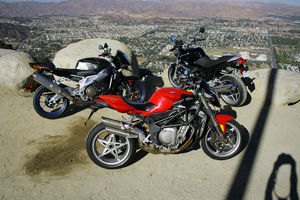













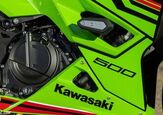







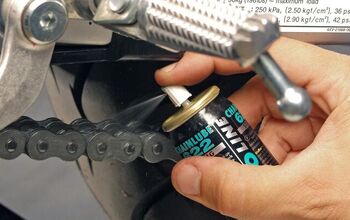



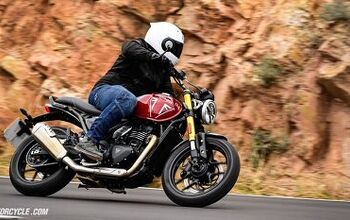


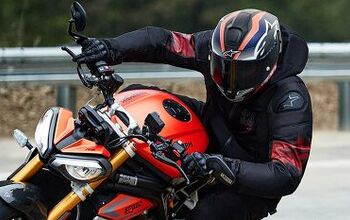

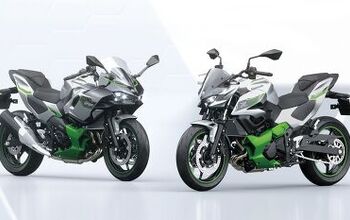

Comments
Join the conversation